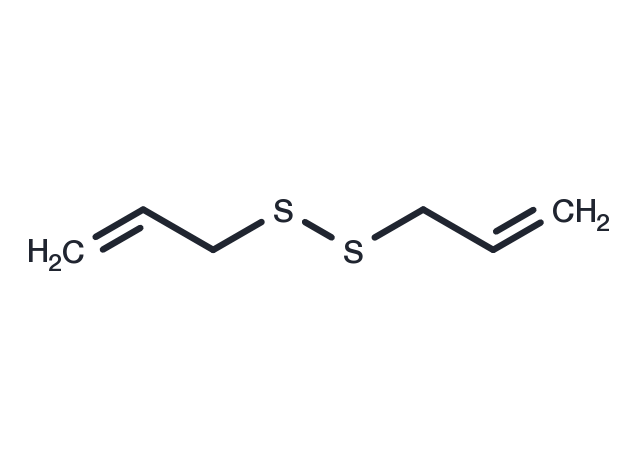Powder: -20°C for 3 years | In solvent: -80°C for 1 year


Diallyl disulfide has antitumor effect, the effect can be enhanced by miR-200b and miR-22.

| Pack Size | Availability | Price/USD | Quantity |
|---|---|---|---|
| 50 mg | In stock | $ 50.00 | |
| 100 mg | In stock | $ 73.00 | |
| 1 mL * 10 mM (in DMSO) | In stock | $ 50.00 |


| Description | Diallyl disulfide has antitumor effect, the effect can be enhanced by miR-200b and miR-22. |
| In vitro | In this study, we evaluated the effects of DADS on airway inflammation using an ovalbumin-induced model of allergic asthma and RAW264.7 cells. DADS decreased nitric oxide production with a reduction in the levels of interleukins (IL)-1β and IL-6 in RAW264.7 cells stimulated with LPS. DADS also reduced the expression of proinflammatory proteins including inducible nitric oxide synthase (iNOS), nuclear factor (NF)-κB, and matrix metalloproteinase (MMP)-9, and it enhanced the expression of antioxidant proteins including Nrf-2 and hemeoxygenase (HO)-1. In in vivo experiments, DADS decreased the inflammatory cell count in the bronchoalveolar lavage fluid (BALF) with IL-4, IL-5, IL-13, and immunoglobulin (Ig) E. These results were consistent with the histological analysis. DADS attenuated the airway inflammation and mucus hypersecretion induced by OVA challenge. In addition, DADS induced the activation of Nrf-2 and the expression of HO-1. In contrast, DADS reduced the activation of NF-κB, iNOS and MMP-9[1] |
| Source |
| Molecular Weight | 146.27 |
| Formula | C6H10S2 |
| CAS No. | 2179-57-9 |
Powder: -20°C for 3 years | In solvent: -80°C for 1 year
DMSO: 7.31 mg/mL (50 mM)
You can also refer to dose conversion for different animals. More
bottom
Please see Inhibitor Handling Instructions for more frequently ask questions. Topics include: how to prepare stock solutions, how to store products, and cautions on cell-based assays & animal experiments, etc.
Diallyl disulfide 2179-57-9 Immunology/Inflammation NF-Κb IL Receptor NOS NF-κB cholesterol biosynthesis squalene monooxygenase Inhibitor Diallyl Disulfide Diallyl inhibit squalene epoxidation inhibitor
